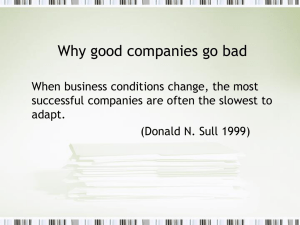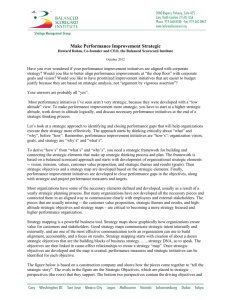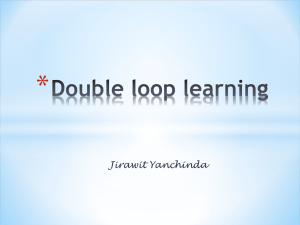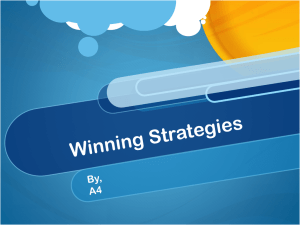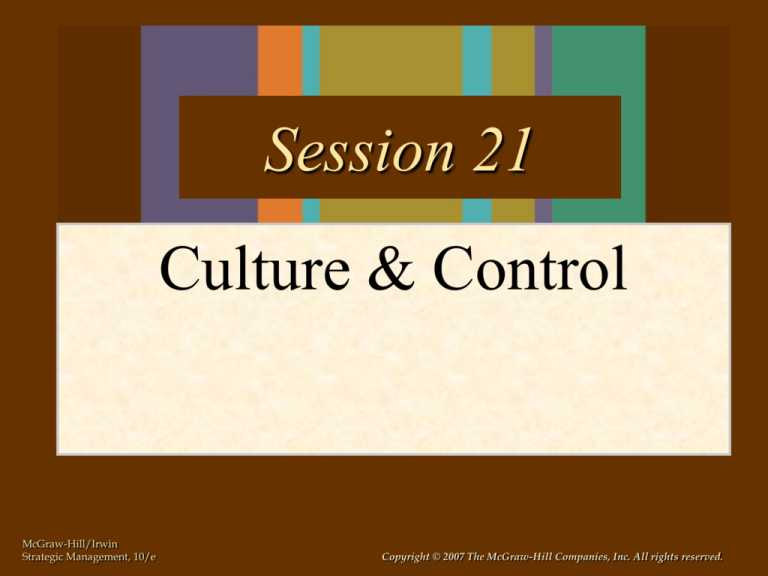
Session 21
Culture & Control
McGraw-Hill/Irwin
Strategic Management, 10/e
Copyright © 2007 The McGraw-Hill Companies, Inc. All rights reserved.
12-2
Learning Objectives
1. Describe the McKinsey Framework as an
Institutionalization tool.
2. Describe the strategy – culture fit.
3. Describe and illustrate four types of strategic
control.
4. Summarize the balanced scorecard approach and
how it integrates strategic and operational control.
5. Illustrate the use of controls to guide and monitor
strategy implementation.
13-2
12-3
McKinsey 7-S Framework
Strategy
Structure
Systems
Shared
Values
(culture)
Skills
Style
(Organizational)
(leadership)
Staff
(Human Capital)
12-4
The Role of the Organizational Leader
•
The leader is the standard bearer, the
personification, the ongoing embodiment of the
culture, or the new example of what it should
become
•
How the leader behaves and emphasizes those
aspects of being a leader become what all the
organization sees are “the important things to
do and value.”
Manage the Strategy-Culture
Relationship
•
Link to mission
•
Maximize synergy
•
Manage around the culture
•
Reformulate strategy or culture
12-5
12-6
Remember: Culture
Eats Strategy for
Breakfast!
12-7
Culture, Structure,
Leadership and Reward
Systems should be
Strategy Based
12-8
celebrate, point out, document,
ritualize, measure and reward
behaviors/skills/actions that
achieve efficiency, innovation,
product quality or
customer responsiveness.
12-9
Establishing Strategic Controls
•
•
Strategic control is concerned with
tracking a strategy as it is being
implemented, detecting problems or
changes in its underlying premises, and
making necessary adjustments
Characterized as a form of “steering
control”
13-9
12-10
Types of Strategic Control
•
•
•
•
Premise control
Strategic surveillance
Special alert control
Implementation control
13-10
12-11
Four Types of Strategic Control
13-11
12-12
Characteristics of the Four Types of
Strategic Control
13-12
12-13
Premise Control
•
Premise control is designed to check
systematically and continuously whether the
premises on which the strategy is based are still
valid
•
Environmental factors
•
Industry factors
13-13
12-14
Strategic Surveillance
•
•
•
Strategic surveillance is designed to monitor a
broad range of events inside and outside the firm
that are likely to affect the course of its strategy
Strategic surveillance must be kept as unfocused as
possible
Despite its looseness, strategic surveillance
provides an ongoing, broad-based vigilance in all
daily operations
13-14
12-15
Special Alert Control
•
•
•
•
A special alert control is the thorough, and
often rapid, reconsideration of the firm’s strategy
because of a sudden, unexpected event
A drastic event should trigger an immediate and
intense reassessment of the firm’s strategy and its
current strategic situation
Crisis teams
Contingency plans
13-15
12-16
Implementation Control
•
•
Strategy implementation takes place as
series of steps, programs, investments, and
moves that occur over an extended time
Implementation control is designed to
assess whether the overall strategy should
be changed in light of the results
associated with the incremental actions
that implement the overall strategy
–
–
Monitoring strategic thrusts
Milestone reviews
13-16
12-17
Balanced Scorecard Methodology
•
•
An alternative approach linking operational and
strategic control, developed by Harvard Business
School professors Robert Kaplan and David
Norton, is a system they names the balanced
scorecard
The balanced scorecard is a management system
(not only a measurement system) that enables
companies to clarify their strategies, translate
them into action, and provide meaningful
feedback
13-17
12-18
Balanced Scorecard
Four perspectives:
1. The learning and growth perspective: How well are we
continuously improving and creating value?
2. The business process perspective: What are our core
competencies and areas of operational excellence?
3. The customer perspective: How satisfied are our
customers?
4. The financial perspective:
How are we doing for our shareholders?
13-18





